
 |
Tea Clipper |
 |
| from TeaAntiques.com | ||
| Edition One Hundred and Twenty One |
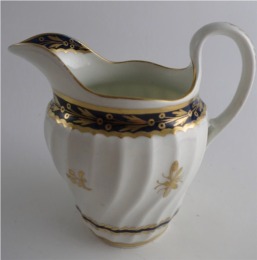
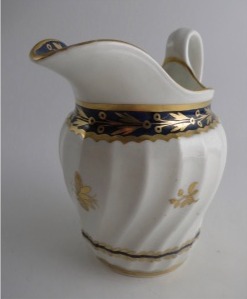
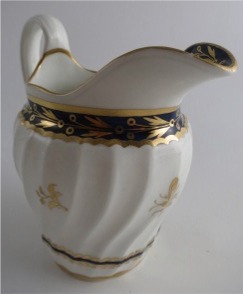
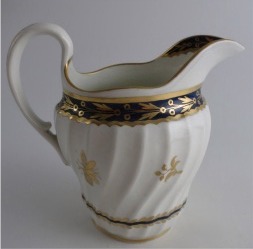
A very elegant and well moulded spiral shanked Milk Jug, decorated with blue and gilt decoration including the gilt 'Fly' motif. This charming Milk Jug was made at the famous Worcester factory c1790. It is marked with the Worcester open blue crescent mark used at the Worcester factory c1755-1790. This delightful Milk Jug dates from c1790.
This very fine quality Milk Jug is moulded with 'shanked' (or spiral) lines which was the latest design in fashion at the later period of the eighteenth century. These moulded lines are very finely potted and create a most decorative effect.
More details of this item and other tea related antiques can be found by visiting my website at www.TeaAntiques.com.
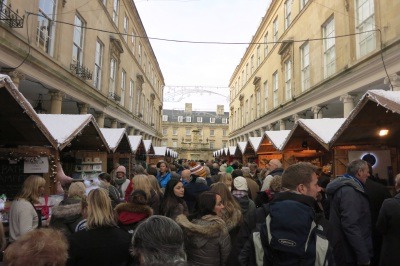
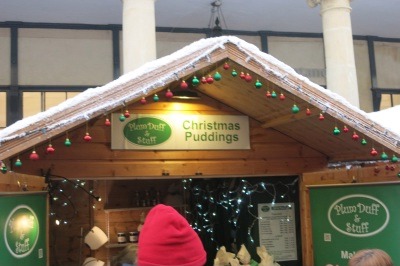
This time I am here to visit one of my favourite houses, Number 1 Royal Crescent. I have reviewed this house in previous Tea Clippers; however, there are some significant changes following the re-opening of the original service wing. Formerly it was part of Number 1 but had been split apart at some time. The Bath Preservation Trust carried out some major restoration and conservation work to integrate the service wing into the museum. The new look museum opened in June 2013.
The extra rooms include a gentleman's retreat, the original kitchen and scullery, some ground floor rooms that provide an interpretation area, a shop on the ground floor and an exhibition space on the top floor. The previous shop in the main house has now be converted back into the Housekeeper's Room and the previous kitchen has been returned to the servants' hall and doubles as a lecture/activities room. The project was called the Whole Story Project.
It is great to see the house looking much as it would have done in the eighteenth century.
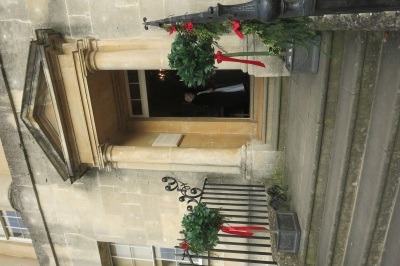 The
house was designed by John Wood the Younger in 1767-1774 as the first house in
the Royal Crescent. Ultimately 29 houses and one hotel were built to make the
spectacular crescent that we see today. Indeed, it is among the greatest
examples of Georgian architecture to be found in the United Kingdom. The 500
foot (150m) long crescent was the first to be built in the rus in urbe
style with its views over parkland - countryside in the town. Some of the
parkland has now been developed but the view remains much as it was across what
is now Victoria Park. Further, the semicircular lawn in front of the crescent is
still owned by the residents.
The
house was designed by John Wood the Younger in 1767-1774 as the first house in
the Royal Crescent. Ultimately 29 houses and one hotel were built to make the
spectacular crescent that we see today. Indeed, it is among the greatest
examples of Georgian architecture to be found in the United Kingdom. The 500
foot (150m) long crescent was the first to be built in the rus in urbe
style with its views over parkland - countryside in the town. Some of the
parkland has now been developed but the view remains much as it was across what
is now Victoria Park. Further, the semicircular lawn in front of the crescent is
still owned by the residents.
It should be remembered that the grand houses in Bath were not intended for permanent residence, but were rented during "the season". Therefore, they didn't have a full complement of rooms that might be found in a London townhouse or a country mansion of the period.
As you arrive at Number One today, you are greeted at the Front Door by a servant in period costume who will invite you to visit their master's house. Before you embark on your exploration, they briefly discuss the history and layout of the house - then you are left to wander back in time. To the left of the front hallway is the dining room, but first we'll visit the gentleman's study on the right of the entrance hall.
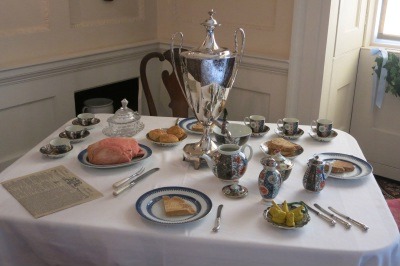 The room is laid for breakfast, a late morning event unlike today.
Breakfast started at around 10am and allowed people to run errands, such as a
visit to the park or library beforehand. "Morning calls" actually took place in the
afternoon!
The room is laid for breakfast, a late morning event unlike today.
Breakfast started at around 10am and allowed people to run errands, such as a
visit to the park or library beforehand. "Morning calls" actually took place in the
afternoon!
On the table are meats, eggs, butter, rolls, toast and a hot water urn. The water urn was not used to serve tea but to provide the hot water to make tea in the teapot. Tea was an expensive commodity and therefore the tea was made in the room by the master or mistress using hot water from the urn. The water was kept hot by inserting a hot rod of metal into a tube in the centre of the urn.
On a side table is a bowl of warm punch, two glasses are already poured out for the master after he returns from his errands. Also in the room is a bureau bookcase at which letters would be written, on a card table a game may be prepared.
It is a gentleman's space.
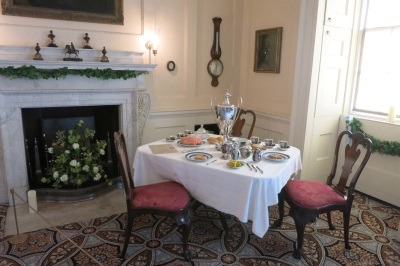
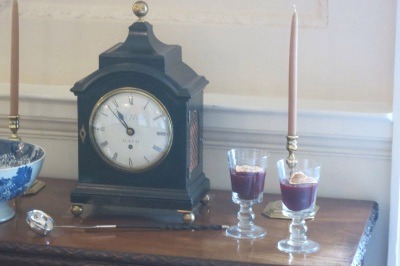
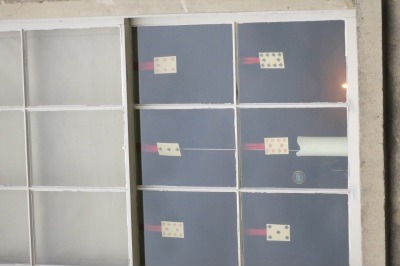 This room is one of the new additions to the Museum
following the Whole Story Project. It shows an area where
the master of the house could retreat with his scientific instruments and books.
It is a small room that may be entered through a door in his study - away from the bustling household, but
with another door to the back stairs should he need to escape! Instruments in the room
include a telescope, aVan der Graaf generator, a world globe and
others; all these are hands-on activities for the visitors.
This room is one of the new additions to the Museum
following the Whole Story Project. It shows an area where
the master of the house could retreat with his scientific instruments and books.
It is a small room that may be entered through a door in his study - away from the bustling household, but
with another door to the back stairs should he need to escape! Instruments in the room
include a telescope, aVan der Graaf generator, a world globe and
others; all these are hands-on activities for the visitors.
Very simple Christmas decoration of some foliage, fruit and playing cards hanging on ribbons in the window.
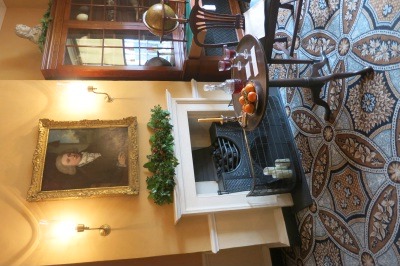
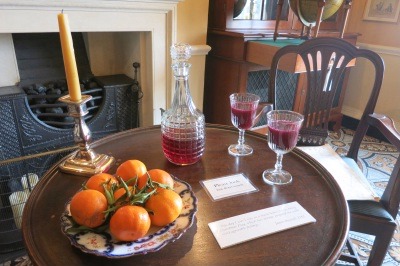
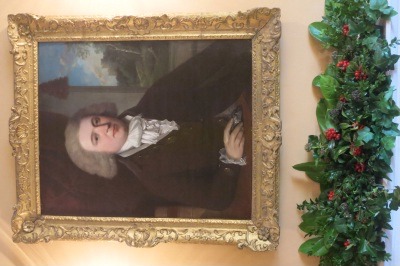
Immediately to the left of the entrance hall is the Dining Room. A magnificent room, light and airy, where a meal is already underway. The table is laid up for the second dining course. After the second dining course, the table cloth was removed and the dessert was laid out for the remove course.
The second dining course required that a new table cloth, dishes and utensils be laid out. This course was lighter than the first, still with meats but now with lighter accompaniments, like sweets, jellies, creams, fruit, candies, tarts, etc.
After dessert, the gentleman would drink port and the ladies a sweet wine, after which the ladies would retire to the drawing room and the gentlemen would continue with the port and gossip.
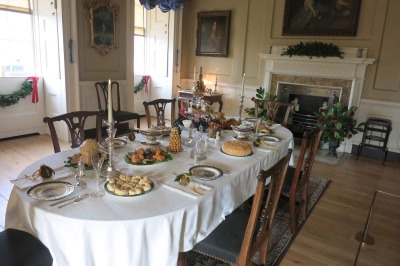
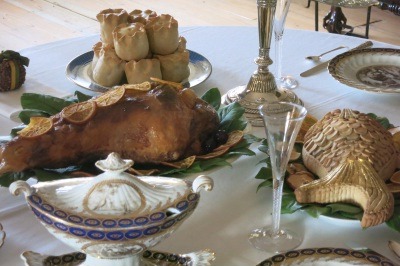
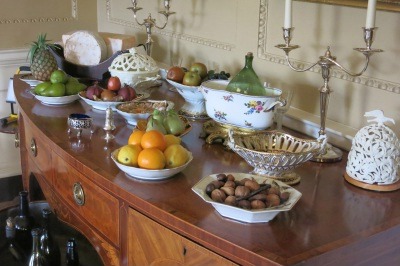
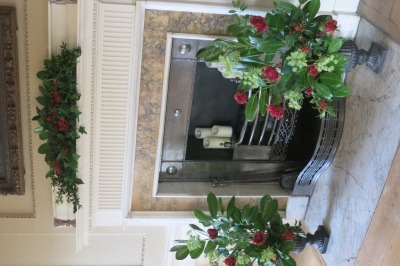
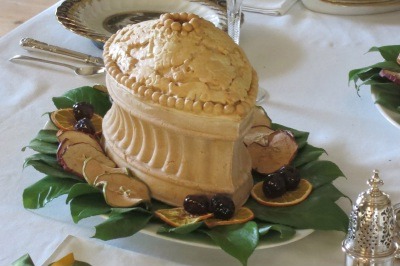
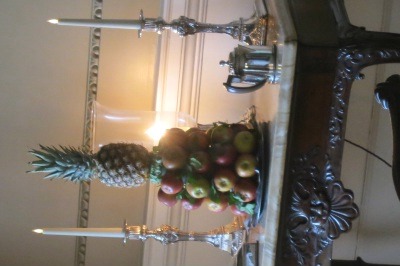
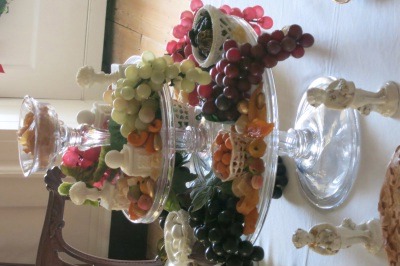
This extract from "The Gentleman's House; How to Plan English Residences from the Parsonage to the Palace." by Robert Kerr, 1865 describes the function of a Drawing Room:
This is the Lady's Apartment, essentially, being the modern form of the Lady's Withdrawing-room, otherwise the Parlour, or perfected Chamber of mediaeval plan. If a Morning-room be not provided, it is properly the only Sitting-room of the family. In it in any case the ladies receive calls throughout the day, and the family and their guests assemble before dinner. After dinner the ladies withdraw to it, and are joined by the gentlemen for the evening. It is also the Reception-room for evening parties. There is only one kind of Drawing-room as regards purpose: there is little difference, except in size and evidence of opulence, between that of the duchess and that of the simplest gentlewoman in the neighborhood...
In size, a small Drawing-room will be about 16 feet wide by from 18 to 20 feet long: 18 by 24 feet is a good size: 20 by 30 to 26 by 40 is enough for a very superior apartment.
In Number One, the Drawing Room is on the first floor and decorated with simple understated Christmas decorations.
Traditional Christmas decorations included holly and evergreen foliage from Christmas Eve onwards as it was considered unlucky to bring greenery into the house before then. Later in the 18th Century, kissing boughs and balls were popular, made from ivy, holly, mistletoe, etc. Oranges studded with cloves, candles, ribbons, fruits also were used as decoration.
The Christmas tree was supposed to have been introduced by Queen Charlotte, wife of King George III in 1800, as it was a German tradition. (It was in the Victorian period that Christmas trees became widely adopted once a picture of Queen Victoria and Prince Albert with their tree was printed in 1848.) The tree in this room has been decorated based on a description of Queen Charlotte's tree in Windsor Castle in 1799.
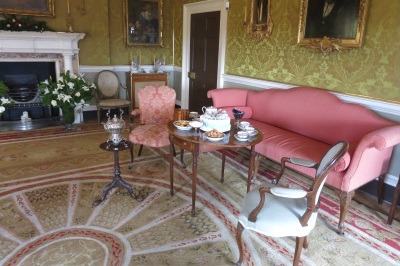
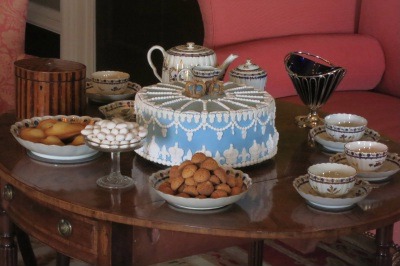
On the tea table is a twelfth night cake; an iced creation with an inner layer of marzipan inspired by the gilded 'marchpane', the centerpiece of Tudor banquets and still remembered today with the marzipan layer of modern Christmas cakes. Within the cake were two beans, who ever gets a bean in their portion will be crowned king or queen for the evening.
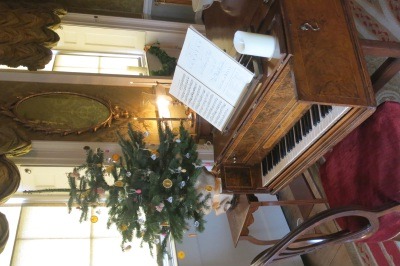
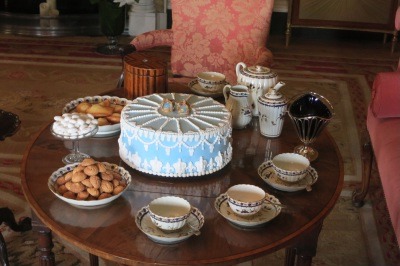
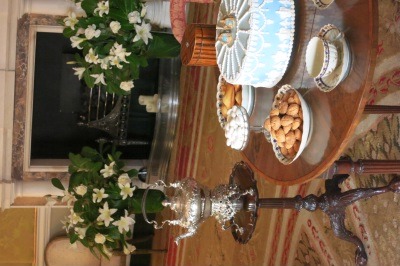
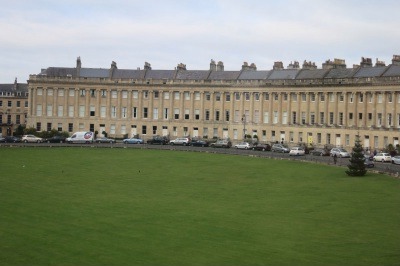 It
is from the Drawing Room that you can get a superb view of the Royal Crescent.
Including the famous Yellow Door at number 22!
It
is from the Drawing Room that you can get a superb view of the Royal Crescent.
Including the famous Yellow Door at number 22!
In 1972, the owner of number 22 painted the front door primrose yellow and installed matching blinds as it was thought it brightened things up. This was in contravention of the council's requirements that all woodwork was to be white, off-white or natural wood. After failing to enforce two orders to repaint the door and following a public enquiry, the Secretary of State for the Environment allowed the door to remain yellow. Who was the owner? It was Miss Amabel Wellesley-Colley, a direct descendant of the Duke of Wellington. It seems she inherited his feistiness and determination to win the battle.
The current owner is continuing with the colour scheme even though it is not a requirement within the deeds to do so!
Opposite the Drawing Room is the Lady's Bedroom. The maid has laid out the mistress's cape and muff for the evening's outing to the Ball at the New Assembly Rooms for the final entertainment before everything stops until after Christmas. They are also attending the Theatre Royal to see a pantomime based on Daniel Defoe's adventures of Robinson Crusoe.
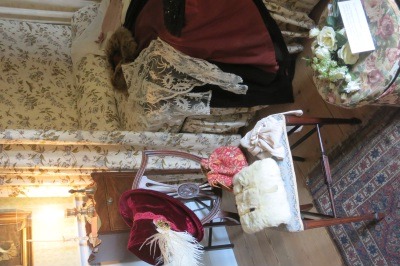
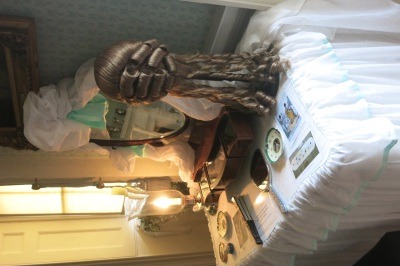
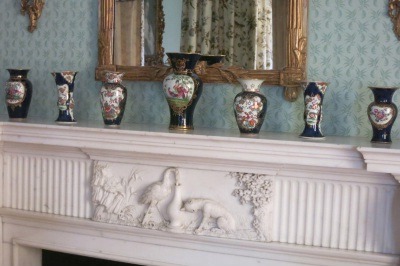
Often called lodgings, these rooms were not rented out but used by male members of the family and guests and simply comprise somewhere to lay their head for the night. The Christmas decoration is very simple - a few playing cards in the window - similar to that in the Gentleman's Retreat downstairs.
On the tray are the ingredients for a "Purge" that the master needs to sort out the indigestion caused by overindulgence at the Ball and Theatre!
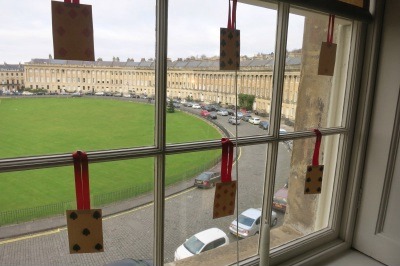
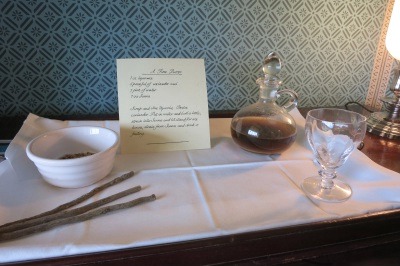
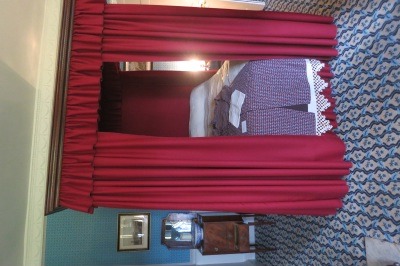
In the basement is the House Keepers's Room, which was the shop before it moved into the newly reclaimed service wing. Now, it shows the heart of the household below stairs. In here the housekeeper looked after all aspects of the smooth running of the staff. Also displayed are cupboards for all the linen: tablecloths, bed linen, napkins, etc.
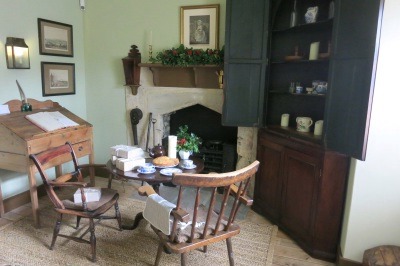
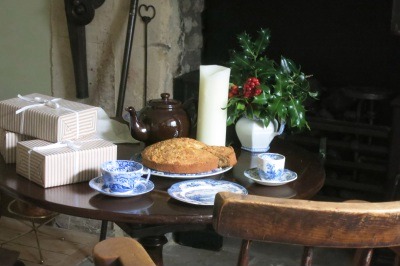
On the table are some boxes for the servants, they will enjoy a few pennies and some left over food. Christmas was a time of charity with gifts for the poor and needy as well as the servants.
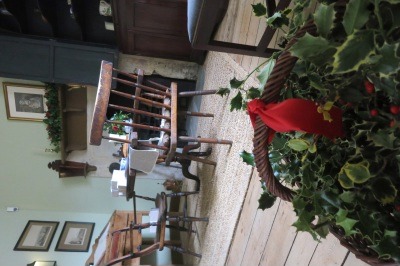
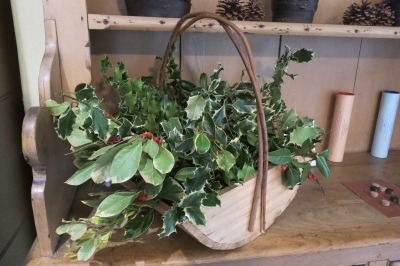
These are two more of the reinstated rooms as part of the Whole Story Project. It is delightful to see the original cooking range and scullery. On display are cooking implements from the period as well as lots of ingredients.
Also on show is the Yule Log, which was a continuing tradition to burn one on Christmas eve. Each year, a piece of the previous year's log was used to kindle the new one, this was supposed to bring and maintain good luck to the household for another year. It was considered bad luck if the log didn't burn for twelve hours! This might be difficult with logs for town houses that didn't have such large hearths as country houses.
Come Bring with a noise |
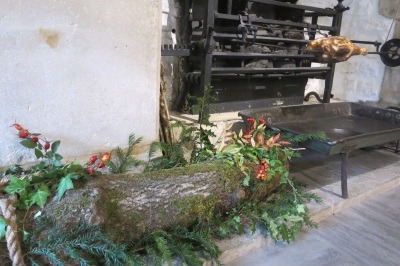
|
On the table are many ingredients for the lavish and plentiful food that will be consumed over Christmas. A pyramid of apples topped by a pineapple is on the side - not just for decoration, but to be eaten. A Christmas pudding is ready for boiling, tarts are being prepared, drop scones are cooking above the range, a kettle is boiling water for tea. A joint of beef is being roasted in front of the range, it is turned using the cogged contraption by harnessing the energy of a falling stone weight.
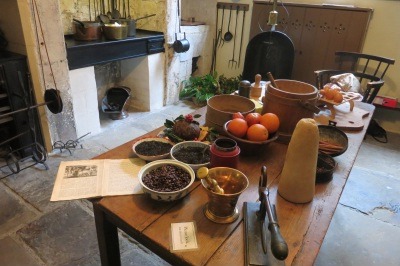
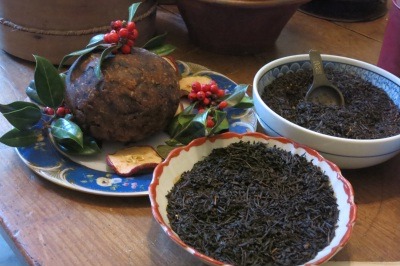
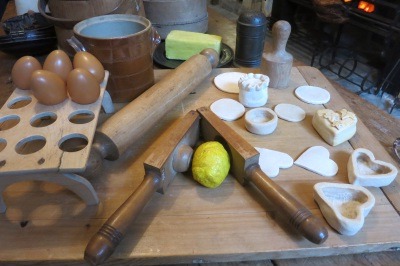
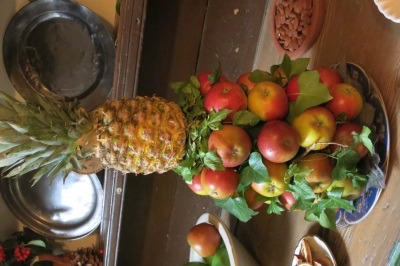
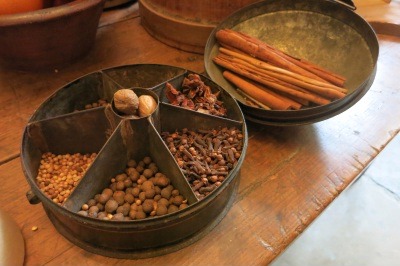
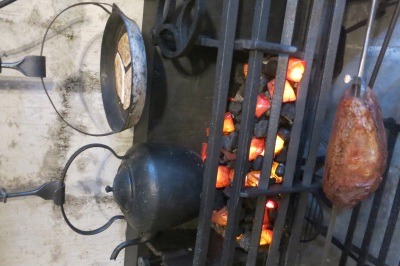
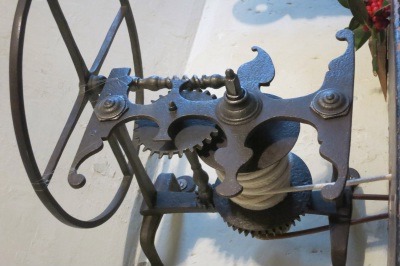
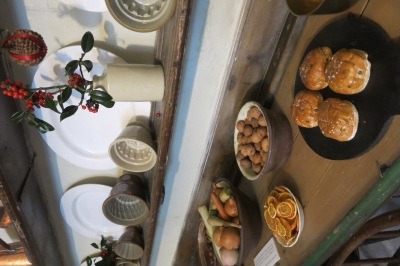
Christmas was a time of hard work for the servants. Lots of extra food to last the twelve days of Christmas had to be ordered and stored. The cook has baked plum cakes and Christmas pies, finished her orders. She's also ordered the best tea, Bohea and Souchong, to be enjoyed upstairs. Early mince pies were highly spiced delicacies that contained beef or tongue and were boat shaped to represent a cradle.
In summary, the Royal Crescent Museum offers a delightfully laid out insight into the lives of the eighteenth century residents.
Number One Royal Crescent Museum
Website: http://no1royalcrescent.org.uk/
Address: 1 Royal Crescent, Bath, BA1 2LR.
One of my favourite restaurants in Bath is the Pump Room in the Roman Baths. It serves an excellent brunch, lunch or afternoon tea. On this visit I enjoyed the eggs benedict with tea whilst listening to the Pump Room Trio whilst I was looked after by wonderful attentive waiting staff. I know I have been here before in earlier Tea Clippers - but it remains one of my favourite indulgences and cannot resist sharing it with you.
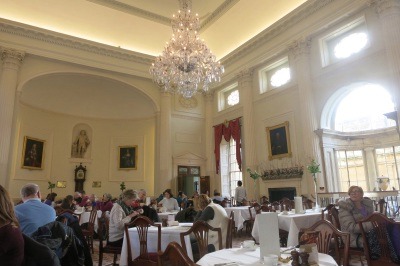
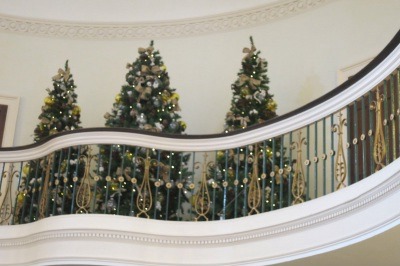
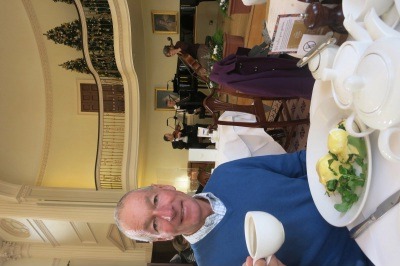
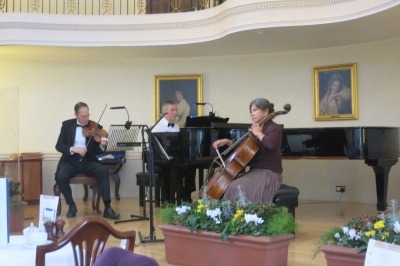
The Pump Room Restaurant
Website: https://www.romanbaths.co.uk/pump-room-restaurant
Address: The Roman Baths, Stall St, Bath BA1 1LZ
To review past newsletters, just follow this link:
Past newsletters.
To subscribe to this free newsletter -
Click here